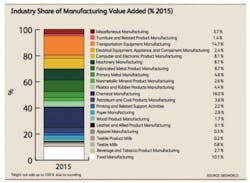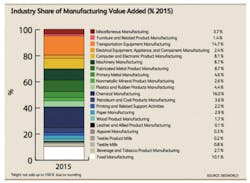The demise of American manufacturing has become a familiar headline. Technological change, deregulation, outsourcing and increasingly competitive foreign producers all continue to do their part in hollowing out the U.S. industrial base. For instance, over the 10-year period to 2015, manufacturing’s share of the U.S. economy (as measured by value added*) is expected to fall from 10.7 percent to 8.1 percent, according to the IBISWorld Sector Analysis: Manufacturing. Similarly, U.S. manufacturing employment is anticipated to fall 15.6 percent over the same period.
However, much of the decline in manufacturing’s share of the economy has been relative, with the service economy expanding at a far faster pace. In reality, many manufacturing industries have continued to expand, and the United States remains one of the largest manufacturers in the world. The following analysis showcases six manufacturing subsectors that have experienced the highest gains and losses over the past decade.
Expanding Subsectors
Chemical Manufacturing
Chemical manufacturing is the largest, and one of the most successful, components of manufacturing in the United States; the subsector accounts for about 16 percent of total manufacturing value added in 2015. Chemical manufacturers produce a wide range of primary, intermediate and end products, including everything from plastics and resin to vitamins and explosives. Chemical manufacturing is expected to generate about $893.3 billion in revenue and employ 777,000 people this year.
Chemical manufacturing owes its success to a number of its largest component industries, which have grown relatively quickly over the past five years. One of these industries is the Organic Chemical Manufacturing industry, which accounts for a substantial 12.3 percent of the chemical manufacturing subsector’s value added.
This industry, which provides raw materials to different downstream manufacturers, has been fueled by strong export growth to emerging market countries, such as China. Chemical manufacturing has also benefited from rapid growth in the Generic Pharmaceuticals industry and the Vitamin and Supplements industry due to rising health consciousness and the growing U.S. population.
The chemical manufacturing subsector has received its largest boost from the Petrochemical Manufacturing industry, whose value added has grown at an annualized rate of 10.5 percent between 2010 and 2015 to account for 11.5 percent of the subsector’s overall IVA. The United States has undergone an energy revolution in recent years due to the advent of hydraulic fracturing, also known as fracking, and horizontal drilling technology, which has made hydrocarbons more accessible than ever before. This drop in the price of natural gas, a primary input to petrochemicals, has made the industry extremely profitable; IBISWorld estimates the average industry operator will achieve profit as high as 19.6 percent of revenue in 2015. Overall, the entire Chemical Manufacturing sector is projected to continue expanding over the next five years, with its revenue surpassing the $1 trillion mark in 2020.
Source: IBISWORLD
Machinery Manufacturing
The production of capital equipment has been another bright spot in the country’s manufacturing activity. The machinery manufacturing subsector includes a range of industries that produce capital equipment necessary in construction, semiconductor production, agriculture, food processing, printing, and oil and gas, among others. In the 10 years to 2015, IBISWorld expects the subsector’s industry value-added to grow at an annualized rate of 1.7 percent. Additionally, employment in machinery manufacturing has increased at an annualized rate of 2.9 percent in the five years to 2015, totaling over 1 million employees.
READ ALSO: Foreign Competition Heats Up In the US Manufacturing Sector
Machinery manufacturing’s industries rely on demand from their distinct downstream markets, but on the whole have experienced growth over the past five years. For example, the Construction Machinery Manufacturing industry, which produces bulldozers, cranes and crawler tractors, is anticipated to grow at an average annual rate of 6.5 percent in the five years to 2015, posting revenue equal to $47.7 billion; underneath this growth is the revival of domestic construction activity, as the economy moves beyond the depths of the recession. The Semiconductor Machinery Manufacturing industry is expected to grow more slowly, with revenue increasing at an annualized rate of 2 percent in the five years to 2015 to $11.7 billion.
While the machinery manufacturing subsector is projected to continue growing over the next five years, its pace will slow. Moreover, despite favorable employment growth during the outlook period, certain machinery manufacturers will likely incorporate advanced robotics in their production processes in the next five to 10 years, resulting in higher productivity.
Fabricated Metal Product Manufacturing
Over the past decade, one of the more successful manufacturing subsectors in the United States has been fabricated metal product manufacturing, generating the third-fastest value-added growth in manufacturing. Fabricated metal product manufacturers primarily transform metal into intermediate or end-products through processes such as forging, stamping, bending, forming and machining. In 2015, the subsector is expected to be the sixth-largest manufacturer in the economy, generating $361.3 billion in revenue and employing 1.3 million people.
The subsector’s performance can be linked to its vital role in the U.S. manufacturing supply chain and increasing exports. In particular, exports’ share of revenue within the subsector has climbed from 6.7 percent in 2005 to an expected 10.9 percent in 2015. The largest and fastest-growing exporter in this subsector has been the Valve Manufacturing industry. The industry accounts for over one-third of the subsector’s exports, leveraging its know-how in oil, gas, refinery and pipeline-related valve manufacturing to win business abroad. On the domestic side, valve manufacturers, as well as those that produce tanks and heat exchangers, have been able to benefit from the country’s large oil, gas, refining and petrochemical sectors. Over the next five years, the subsector is expected to continue growing; however, the recent plunge in oil prices may temper demand for its resource-related products.
Contracting Subsectors
Apparel manufacturing
The Apparel Manufacturing subsector has experienced a prolonged decline over the past 10 years. The United States has lost about 90 percent of its apparel manufacturing jobs over the past two decades due to high import penetration. Imports as a share of domestic demand have increased from 75.9 percent in 2005 to 92.5 percent in 2015. Apparel manufacturing in general is a highly labor-intensive process, and minimum wage standards in the United States are high compared with other countries. This has driven many producers to move offshore to countries such as Bangladesh and Vietnam, where wages are more competitive.
Overall, this migration has translated into an annualized decline of 0.6 percent in the number of apparel manufacturing enterprises over the past 10 years. Apparel manufacturing revenue has similarly fallen at a rate of 11.5 percent per year on average to $8.8 billion in 2015. Today, this subsector represents 0.3 percent of manufacturing value added, down from 0.7 percent in 2005.
As manufacturers move overseas, capital investments in this subsector will continue to dwindle domestically. Operators find little need to spend money on new machinery when the production process is done primarily by hand in low labor-cost countries. However, the industry is expected to benefit from reshoring, as it becomes increasingly expensive to produce in China, and industry operators begin looking to other countries, including the United States, as potential hubs for production operations. This movement should decrease the rate of revenue decline within the industry, but is not expected to induce a recovery.
SOURCE: IBISWORLD
Printing and Related Support Activities
Among the manufacturing industries that have experienced the most dramatic decline are those involved in printing books, lithographs, business forms and other paper products. IBISWorld expects the printing subsector’s industry value-added to decline at an annualized rate of 4.6 percent in the 10 years to 2015, representing one of the steepest within the manufacturing sector.
This subsector is dominated by the Printing industry, which is expected to generate over 90 percent of the subsector’s revenue in 2015. In the five years to 2015, IBISWorld expects revenue for the Printing industry to contract at an average annual rate of 1.3 percent to $82.7 billion. This decline in printing has been the result of consumers and businesses increasingly relying on digital forms for communication and media purposes. Additionally, the increasing price of paper and consistent decline in print advertising has contributed to the subsector’s atrophy.
Over the next five years, this sector is projected to continue declining. In particular, digital adoption and replacement will likely accelerate, placing greater pressure on printing operators. Greater adoption of smartphones and the rollout of cloud computing and next-generation Internet connectivity will mark the turn toward digital content.
Furniture and Related Product Manufacturing
One of the worst-performing subsectors within U.S. manufacturing has been furniture and related product manufacturing, with its share of the U.S. economy expected to more than half in the 10 years to 2015. The companies in this subsector produce everything from cabinets to mattresses; the Household Furniture Manufacturing and Office Furniture Manufacturing industries account for about two-thirds of the subsector’s $75.1 billion in revenue.
Over the past decade, this subsector was hit hard by the housing market crash and climbing import penetration. The housing crash and the subsequent recession caused furniture manufacturing to significantly contract, as households held off furniture purchases and businesses withheld similar investments. However, the subsector’s long-term problem lies with highly competitive imports. In particular, low-cost imports from countries such as China have undercut domestic producers. Moreover, foreign competition further intensified as the recession hit and consumers became far more price conscious.
From 2005 to 2015, imports’ share of domestic demand is expected to rise from 23.3 percent to 32.6 percent. Faced with a weakened domestic market and import substation, many subsector players went bankrupt or restructured. Consequently, sector employment fell by nearly 40.0 percent over the past 10 years, to about 344,000 people. Over the next five years, a recovering housing market and economy will help improve the subsector’s performance. Nonetheless, it will continue to shrink due to import substitution.
*Industry value added measures an industry’s contribution to the economy and the wealth it creates by labor, depreciation and profit.




